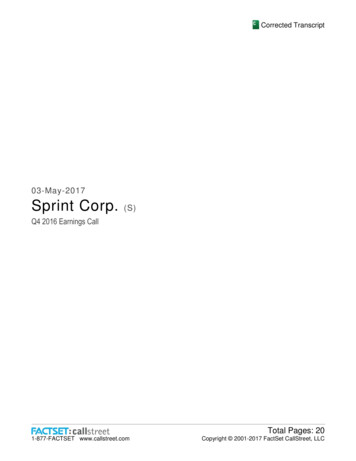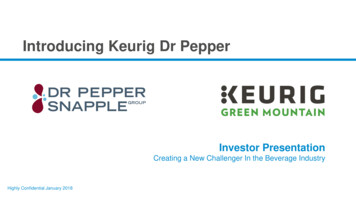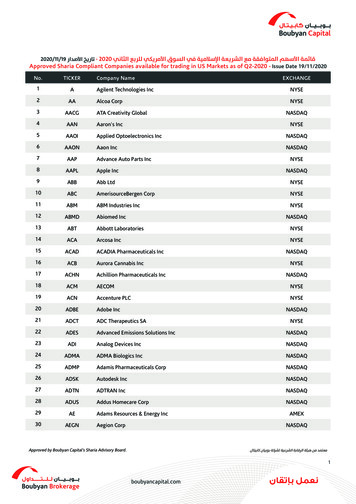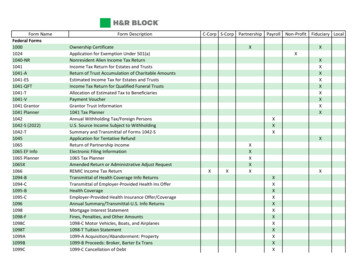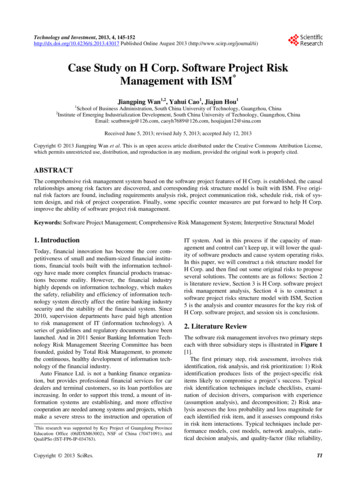
Transcription
Technology and Investment, 2013, 4, 145-152http://dx.doi.org/10.4236/ti.2013.43017 Published Online August 2013 (http://www.scirp.org/journal/ti)Case Study on H Corp. Software Project RiskManagement with ISM*Jiangping Wan1,2, Yahui Cao1, Jiajun Hou11School of Business Administration, South China University of Technology, Guangzhou, ChinaInstitute of Emerging Industrialization Development, South China University of Technology, Guangzhou, ChinaEmail: scutbmwjp@126.com, caoyh7689@126.com, houjiajun12@sina.com2Received June 5, 2013; revised July 5, 2013; accepted July 12, 2013Copyright 2013 Jiangping Wan et al. This is an open access article distributed under the Creative Commons Attribution License,which permits unrestricted use, distribution, and reproduction in any medium, provided the original work is properly cited.ABSTRACTThe comprehensive risk management system based on the software project features of H Corp. is established, the causalrelationships among risk factors are discovered, and corresponding risk structure model is built with ISM. Five original risk factors are found, including requirements analysis risk, project communication risk, schedule risk, risk of system design, and risk of project cooperation. Finally, some specific counter measures are put forward to help H Corp.improve the ability of software project risk management.Keywords: Software Project Management; Comprehensive Risk Management System; Interpretive Structural Model1. IntroductionToday, financial innovation has become the core competitiveness of small and medium-sized financial institutions, financial tools built with the information technology have made more complex financial products transactions become reality. However, the financial industryhighly depends on information technology, which makesthe safety, reliability and efficiency of information technology system directly affect the entire banking industrysecurity and the stability of the financial system. Since2010, supervision departments have paid high attentionto risk management of IT (information technology). Aseries of guidelines and regulatory documents have beenlaunched. And in 2011 Senior Banking Information Technology Risk Management Steering Committee has beenfounded, guided by Total Risk Management, to promotethe continuous, healthy development of information technology of the financial industry.Auto Finance Ltd. is not a banking finance organization, but provides professional financial services for cardealers and terminal customers, so its loan portfolios areincreasing. In order to support this trend, a mount of information systems are establishing, and more effectivecooperation are needed among systems and projects, whichmake a severe stress to the instruction and operation of*This research was supported by Key Project of Guangdong ProvinceEducation Office (06JDXM63002), NSF of China (70471091), andQualiPSo (IST-FP6-IP-034763).Copyright 2013 SciRes.IT system. And in this process if the capacity of management and control can’t keep up, it will lower the quality of software products and cause system operating risks.In this paper, we will construct a risk structure model forH Corp. and then find out some original risks to proposeseveral solutions. The contents are as follows: Section 2is literature review, Section 3 is H Corp. software projectrisk management analysis, Section 4 is to construct asoftware project risks structure model with ISM, Section5 is the analysis and counter measures for the key risk ofH Corp. software project, and session six is conclusions.2. Literature ReviewThe software risk management involves two primary stepseach with three subsidiary steps is illustrated in Figure 1[1].The first primary step, risk assessment, involves riskidentification, risk analysis, and risk prioritization: 1) Riskidentification produces lists of the project-specific riskitems likely to compromise a project’s success. Typicalrisk identification techniques include checklists, examination of decision drivers, comparison with experience(assumption analysis), and decomposition; 2) Risk analysis assesses the loss probability and loss magnitude foreach identified risk item, and it assesses compound risksin risk item interactions. Typical techniques include performance models, cost models, network analysis, statistical decision analysis, and quality-factor (like reliability,TI
146J. P. WAN ET AL.Figure 1. Software risk management steps.availability, and security) analysis; 3) Risk prioritizationproduces a ranked ordering of the risk items identifiedand analyzed. Typical techniques include risk-exposureanalysis, risk-reduction leverage analysis (particularly involving cost-benefit analysis), and Delphi or group-consensus techniques.The second primary step, risk control, involves riskmanagement planning, risk resolution, and risk monitoring: 1) Risk-management planning helps prepare you toaddress each risk item (for example, via information buying, risk avoidance, risk transfer, or risk reduction), including the coordination of the individual risk-item planswith each other and with the overall project plan. Typicaltechniques include checklists of risk-resolution techniques, cost benefit analysis, and standard risk managementplan outlines, forms, and elements; 2) Risk resolution produces a situation in which the risk items are eliminated orotherwise resolved (for example, risk avoidance via relaxation of requirements). Typical techniques include prototypes, simulations, benchmarks, mission analyses, keypersonnel agreements, design-to-cost approaches, and incremental development; 3) Risk monitoring involves tracking the project’s progress toward resolving its riskCopyright 2013 SciRes.items and taking corrective action where appropriate. Typical techniques include milestone tracking and a top-10risk-item list that is highlighted at each weekly, monthly,or milestone project review and followed up appropriately with reassessment of the risk item or corrective action.J. P. Wan, D. Wan, and H. Zhang identified the risksof CN Group which is working at software outsourcingprojects between Hong Kong and Guangdong, discoversthe causal relationships among the risk factors, and constructs corresponding risk structure model with Interpretive Structural Modeling. Five original risk factors areidentified, including contracts risk, requirements definition and change, lack of communication, political and legal environment differences, and exchange rate fluctuations [2]. J. P. Wan and D. J. Wan figured out elevenkinds of common mindbugs are figured out among thetwenty five kinds of mindbugs with questionnaire. Therelationship between the six root risk factors of implementation of the information technology service management (ITSM) project and these common mindbugs arealso identified [3]. J. P. Wan and L. Y. Liang selected fivecommon killer assumptions from Warfield’s 17 Killer assumptions through empirical analysis. Enterprise interviewTI
J. P. WAN ET AL.and questionnaire survey are used to establish and verifythe relational model between the root risk factors of implementation of the ITSM project and the six complexitypropositions based grounded theory [4]. J. P. Wan and J.J. Hou studied the possible risk factors during SAP Business One implementation with depth interview. The results were then adjusted by experts. 20 categories of riskfactors that are totally 49 factors were found. Based onthe risk factors during the SAP Business One implementation, questionnaire was used to study the key risk factors of SAP Business One implementation. The studyillustrated that the structure is olive-like, in which therisk of data import is on the top, and the risk of seniormanagers is on the bottom [5].3. H Corp. Software Project RiskManagement Analysis3.1. The Overview of H Corp. and Its SoftwareProjectH Corp. is the first Auto Finance Ltd. in Guangdong province, providing auto financing services for car dealersand terminal customers of its parent company’s relatedbrands. Its core business platforms consist of automotiveretail credit business system (NETSOL), approval systemfor inventory business, capital management system, general ledger system, and the data warehouse platform. Allthe other systems are referred to as peripheral systems. Inthe process of the project, core business systems are in147the center, peripheral systems can communicate with thecores directly, or via the agency. Strict message rules, definite handshakes and rigorous enciphered message shouldbe established for smooth communication.There are several features of H Corp. software projects.1) Both core business systems and peripheral systems areclosely related to the business and its process; 2) Thespecifications are very strict in many aspects, includingproject, document, process, design, development, code,test, end of the project, etc. We should comply with thespecifications strictly; 3) All the projects are affiliated tothe IT department, but the requirements are put forwardby the related business departments; 4) It’s only cooperation with each other that we can success; 5) The fruits ofthe project are not only the project itself, but also something abiding the specifications, including SC (source code),design document, prototypes, operation manual, and inspection report, etc.3.2. Analysis of Comprehensive RiskManagement SystemA comprehensive risk management system is establishedfor the success of H Corp. Software project (Figure 2).The contents are as follow. 1) The environment of riskmanagement can be divided into the internal and the external. Including the culture of risk management, the project management policy, matrix organization structure,etc.; 2) The policy of risk management is to define theprocess and content of the risk management, formulateFigure 2. Comprehensive risk management system.Copyright 2013 SciRes.TI
148J. P. WAN ET AL.the report template for the regular work; 3) We will makea detailed instruction about the process of risk identification in the part 4; 4) Risk evaluation contains qualitativeanalysis and quantitative analysis, is to make sure theeffect and loss extent of the risk accidents; 5) After theidentification and evaluation of the risk, we can makespecific counter measures to response the risk; 6) A internal control system should be established by internalcontrol department and continuous control department todiscover the problem, propose the improvement plan andput it into effect; 7) Recognize, judge, analyze and evaluate the risk source, then dispose and make a report. Thisprocess will provide basis for the next risk coming; 8)The constant improvement of risk management can bebased on Kaizen Process-PDCA.3.3. The Construction of Comprehensive RiskManagement SystemWe can construct the comprehensive risk managementsystem of H Corp. software project in three aspects. Firstly,on the aspect of organizational structure, we should makesure that board of directors, executive and Communication and Information Technology Commission (CITC)will be responsible for IT risk strategy, and resource allocation. The orientation of IT risk management institutions should be defined. The IT risk management responsibility of every department should be clear. Three linesof defence has been established as follow (Figure 3), andIT management department, risk management department,each business line in the front, each support department inthe background, institutions at all levels should be fullyparticipated. Second, on the policy aspect, IT risk shouldbelong to company risk management policy. Last, on theprocess aspect, IT management department should reportto department head and Chief Risk Officer discretely,analyze the IT cases regularly, complete the policy, andpromote the improvement of management process andsolution of the problem.3.4. Software Project Risk Control StrategyIn view of comprehensive risk management system, therisk management of the software project has the following steps: 1) Build enterprise risk management culture,make more training and communication to improve theinternal risk management environment; 2) Set clear riskmanagement objectives and policies; 3) Establish a perfect risk identification and monitoring system; 4) improvethe skill of risk evaluation continuously; 5) Perfect riskcounter measures step by step, and establish risk databasein order to prevent the risk advance; 6) Establish a perfect internal control system led by the continuous controldepartment; 7) Set up a risk disclosure and reporting system; 8) Establish the continuous improvement system ofrisk management.4. Construct a Software Project RisksStructure Model with ISM4.1. Identify the Risks of the Software ProjectThe major event sequence of ISM is in the following [6]:1) Theme is selected; 2) Developer is identified; 3) Elements and contextual relation are identified; 4) Leader isidentified; 5) ISM program is entered in computer; 6)Adequate computer time is allocated; 7) Facilities areFigure 3. The structure of H Corp. software project risk management system.Copyright 2013 SciRes.TI
149J. P. WAN ET AL.ready; 8) Session plan is complete; 9) Computer containselements and contextual relation; 10) Session can begin;11) Element set is edited; 12) Reachable matrix is complete; 13) Total structure is available; 14) Amendmentsare complete; 15) Final structure is satisfactory.According to the ten risk categories of financial services proposed by the Basel Committee on Banking Supervision, we deeply analysis the risk we met in theprocess of the project from aspects, such as the risk types,risk description, risk probability, risk incidence, processing mode, etc. Then 20 major risk factors of IT projectsof H Corp. were found out. These risks can be illustratedin Table 1.We consult with experts, who come from company internal risk management team or project team with Delphi,including Project managers, Developers, Testers, Business personnel, Software development and the internalcontrol manager, QA, etc. By the way of calculating variable coefficient, we analysis the opinions of the experts,then conclude the descriptive statistics risks of softwareproject, which can be illustrated in Table 2.4.2. Construct Adjacency Matrix and ReachableMatrixConstruct an adjacency matrix according to risk factorsand its weight. It is illustrated in Figure 4.Calculate by ISM Win 1.1, we can get a reachable matrix. It is illustrated in Figure 5.4.3. Construct the Re-Order Reachable MatrixM’According to the result of class division, we can get there-order reachable matrix as follows (Figure 6).Table 1. Major risks of software project of H corp.No.Risk factorDescriptionPrIHa1 Outsourcing decision-making riskWhen choosing the outsourcing supplier, company executives make a wrong decision.LBA2 Supplier selection blundersSupplier selection blunders caused by inaccurate evaluation to the core capability andprocess capability of the suppliers.LBA3 Inaccurate requirement analysisThe feasibility analysis to the requirement submitted by business departments is notin-depth, leading to bias.HBA4 The risk of requirement changeInaccurate requirements submitted by business departments are changing continuously,even lead to the expanding of project scope.HBA5 Design deviationIn the design, system processing errors are caused by improper method, vicious andincomplete functional design.MBA6 Losing control of milestonesThe company, paying less attention to the supervision, lead supervision out of control.HMC7 The lack of client supportClient’s active cooperation is critical for project success.MMC8 Inaccurate evaluation criteriaIn the project contract, the evaluation criteria about project acceptance, test plans andproject deliverables are inconsistent.LSADue to technology, personnel capacity, resources, or lack of responsibility, systememerges some errors, which may affect the security of the system.MBC10 Expectations of clientsThe project functions can’t meet the clients’ expectations.MBAl11 After service riskTechnical support personnel is not in place, and the program can’t be solved in time, andso on.MBA12 Document riskDocument content description is not clear and not up to specification.MMA13 Communication riskSupplier’s work mechanism can not play a normal role.MMC14 Contract riskThe issues of technology or capital are caused by contract defects and the wrong choiceof contract type.LMA15 Human resources riskFlow of people, especially technology backbones.MBC16 Time riskProject delay is caused by staffing or expanding of project scope.HMC17 Cost riskThe cost exceeds project expected expenses.MMC18 Outsourcing riskHighly depending on outsourcer, so when the outsourcer has problems, the project will beinterrupted.LBP19 Team management riskIt mainly caused by the imperfection of system construction,construction process, coordinate control, emergency management, etc.HBP20 Political and legal riskDifferent countries have different political systems and legal environments. So thecompany, different cultures and management systems will make staffs different.LMA9Software development can notmeet the requirementsNote: Pr: Probability, I: Incidence, Ha: Handling, L: Low, M: Middle, H: High, B: Big, S: Small, C: Control, A: Avoid, Al, alleviate, P: Prevent.Copyright 2013 SciRes.TI
150J. P. WAN ET AL.Table 2. The descriptive statistics risks of software project.Risk factorsNumber WeightDescriptionInaccurate requirementanalysisS14.31The content of requirements is not clear, so it’s easy to change. Technicist’s misunderstanding ofrequirements, Requirements analysis errors, etc.Supplier selection blundersS24.25Supplier selection blunders caused by inaccurate evaluation to the core capability and processcapability of the suppliers.The risk of requirementchangeS34.25Inaccurate requirements submitted by business departments is changing continuously, even lead tothe expanding of project scope, rising costs and schedule delays.S44.19When choosing the outsourcing supplier, company executives make a wrong decision.Outsourcing decision-makingriskThe lack of client supportS54Losing control of milestonesS63.88Design deviationS73.81Caused by design errors, vicious and incomplete functional design, using new technology.Communication riskS83.75Supplier’s work mechanism can not play a normal role.Client’s active cooperation is critical for project success.The company, paying less attention to the supervision, lead supervision out of control.Human resources riskS93.69Flow of people, especially technology backbones.Time riskS103.63Project delay is caused by staffing or expanding of project scope.Figure 6. The re-order reachable matrix R’.Figure 4. Adjacency matrix.Figure 7. Risk management structural model for H Corp.4.5. Analyze the Interpretive Structural ModelFigure 5. Reachable matrix.4.4. Construct the Interpretive Structural ModelAccording to the re-order reachable matrix, we can construct the risk structural model of H Corp. They can beillustrated by Figure 7.Copyright 2013 SciRes.After the analysis, we discover the software project riskfactors of H Corp. in four level structures (Figure 8). Itcan be seen from Figure 7 that this model is a directedfour-level hierarchical structure model, and that the bottom-line arrows indicate low-level factors affecting highlevel factors. By replacing risk factors code with the actual risk factors, the interpretative structure model of H’ssoftware project risk is established.TI
J. P. WAN ET AL.151Figure 8. Interpretive structure model of H Corp. software project risk management.1) The lowest level constitute of human resource risk,supplier selection blunders, and communication risk. Theyare the key factors affecting the success of software projects; especially, the risk of supplier selection blundersoccur in the early stages of operation of software projects,having significant impact on the process of cooperationand success of H Corp.’s project. So it deserves muchmore attention.2) The factors of the second layer is the direct riskfactors resulting H Corp. to crisis, including time risk,losing control of milestones, and the risk of requirementchange. Three risks are indirectly affected by a variety ofrisk factors.3) Uncertain demand analysis, design deviation, thelack of client support and outsourcing decision-makingfailure is the direct reason, which leads to the projectschedule risk, losing control of milestones, demand change.The direct reasons should be monitored in the process ofsoftware project.4) Time risk mainly due to design deviation, the lackof client support, outsourcing decision-making risk, inaccurate requirement. The deeper reasons are lacking ofeffective communication, the mistakes in selection ofsuppliers is caused by lacking comprehensive assessmentof suppliers’ technical human resource and managementlevel results, the team human resource changing, and technological level & professional skill falling behind.5. The Counter Measures for the RiskManagement of H Corp. Software ProjectAccording to the ISM model above, we discover fivecritical risks of H Corp. software project, which constitute of requirements analysis risk, project communicationrisk, schedule risk, risk of system design, and risk ofCopyright 2013 SciRes.project cooperation. Now we will analysis the criticalrisks and try to put forward some specific counter measures.5.1. Requirements Analysis RiskThere are three typical requirements analysis risks in theprocess of software project, critical users can’t participate in the process of requirements analysis, so the teamcan’t accurately grasp the user’s real requirements; withthe micro-increasing of the project functions and features,the requirements of the project is extending; and the business requirements jump when the project functions andfeatures are changing obviously. Facing these risks, wecan apply the measures as follows. 1) control the requirements change by specifying the process, defining the criteria, confirming the priority rating, or guiding the changeby communicating; 2) control the requirement quality byspecifically investigating the critical users; 3) control therequirements understanding deviation caused by the differences between business personnel and technical personnel in the professional background and job field bycommunicating sufficiently or confirming repeatedly.5.2. Project Communication RiskLack of communication, the business personnel, IT developers and the technical team of outsourcers would nottake fully advantage of cooperation. In order to communicate in time, we can do as follows: 1) formulate a detailed project communication plan; 2) keep in touch closely with project stakeholders by various channels of communication; 3) hold the project team meeting regularly; 4)questionnaire survey first to make project requirementsand difficulties clear in the requirements analysis phaseTI
152J. P. WAN ET AL.of the project. 5) because of the special personality of thefinancial system project, there is no general developmentmode in the industry, so the support should be timelyprovided by the business analysts.5.3. Project Schedule RiskProject delay not only makes members under high pressure, but also leads to the dissatisfaction of the stakeholders. The counter measures are in the following. 1) establish a communication system and the technical personnelshould be trained heavily to improve the ability for handling problems; 2) define the project process to makesure the project-related personnel can finish their ownjob on time; 3) make sure all the team members know allthe project requirements; 4) formulate the project emergency plan; 5) show the project fruit in time in the process to motivate the team members.5.4. Risk of System DesignThe risk of system design mainly includes integrity risk,risk of data storage, data acquisition risk and risk of architecture, etc. The counter measures are in the following.1) establish review committee and change managementsystem; 2) define the criteria of connector to the differentApps; 3) according to the method of system engineeringand certain criteria, combining with the principle of management information system, under the condition of thestable system structure frame, develop business systemsstep by step. An integrated planning of the system and certain technical criteria should be defined by IT department.By doing these, we could make sure the success of thepresent project, the stability of data changing among thesystems, and reduce the risk of project failure. So the construction of the IT system is under the control.5.5. Risk of Project CooperationThe risks of project cooperation not only refer to the riskinside the project team and between different departments,but also contain all the risks between company and outsourcers in the process. In order to avoid these risks, wecan follow the counter measures. 1) Project managersshould pay more attention to the leadership and management; 2) when it comes to the part outsourcing of theproject, we should fully consider the feasibility and cost,and rigorously evaluate the outsourcers, including technology, management level, corporate organizational structure, industry experience, and after-sale service, etc.; 3)Team members should keep good touch with each otherand learn to communicate with the supplier forwardly; 4)A training to technical personnel of outsourcers shouldbe conduct by IT department in accordance with the continuous control institution of the company; 5) When theCopyright 2013 SciRes.project environment changing, IT department should evaluate its effect to the service of the outsourcers, and putforward the related plan to make sure the success of theproject; 6) In the process of system development, wecould apply related counter measures to ensure information security management fit the institution of the company; 7) After system launched and operated normally,IT department should found a effective communicationsystem with the outsourcers, so as to acquire technicalsupport in time.6. ConclusionThe comprehensive risk management system based onthe software project features of H Corp. is established,the causal relationships among risk factors are found, andcorresponding risk structure model is built with ISM.Five original risk factors are found, including requirements analysis risk, project communication risk, schedule risk, risk of system design, and risk of project cooperation. Finally, some specific counter measures are putforward to help H Corp. improve the ability of softwareproject risk management.7. AcknowledgementsThanks for helpful discussion with Mr. Jinghe Wang, etal.REFERENCES[1]B. W. Boehm, “Software Risk Management: Principles andPractices,” IEEE Software, Vol. 8, No. 1, 1991, pp. 3241. doi:10.1109/52.62930[2]J. P. Wan, D. Wan and H. Zhang, “Case Study on Business Risk Management for Software Outsourcing Service,” Technology and Investment, Vol. 1, No. 4, 2010,pp. 173-194. doi:10.4236/ti.2010.14033[3]J. P. Wan and D. Wan, “Analysis on the Mindbugs in Information Technology Service Management Project Implementation,” Technology and Investment, Vol. 2, No. 3,2011, pp. 184-192. doi:10.4236/ti.2011.23019[4]J. P. Wan and L. Y. Liang, “Risk Management of IT Service Management Project Implementation with Killer Assumptions,” Technology and Investment, Vol. 3, No. 1,2012, pp. 48-55. doi:10.4236/ti.2012.31007[5]J. P. Wan and J. J. Hou, “Research on SAP Business OneImplementation Risk Factors with Interpretive StructuralModel,” Journal of Software Engineering and Applications, Vol. 5, No. 3, 2012, pp. 147-155.doi:10.4236/jsea.2012.53022[6]J. N. Warfield, “The Mathematics of Structure,” AJAR Publishing Company, Palm Harbor, 2003.TI
3.4. Software Project Risk Control Strategy . In view of comprehensive risk management system, the risk management of the software project has the follow- ing steps: 1) Build enterprise risk management culture, make more training and communication to improve the internal risk management environment; 2) Set clear risk



